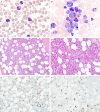Therapy-related acute myeloid leukemia with eosinophilia, basophilia, t(4;14)(q12;q24) and PDGFRA rearrangement: a case report and review of the literature
- PMID: 26191303
- PMCID: PMC4503174
Therapy-related acute myeloid leukemia with eosinophilia, basophilia, t(4;14)(q12;q24) and PDGFRA rearrangement: a case report and review of the literature
Abstract
The myeloid and lymphoid neoplasms with eosinophilia and PDGFRA gene rearrangements usually show a good response to Imatinib and are typically associated with a normal karyotype, occasionally exhibiting a secondary chromosomal abnormality associated with clonal evolution. Five variant translocations involving PDGFRA have been reported. Here, we report a rare case of therapy-related acute myeloid leukemia with PDGFRA rearrangement after chemotherapy for prior B lymphoblastic leukemia (B-ALL). The patient had a history of BCR-ABL negative, hypodiploid B-ALL in complete remission after chemotherapy. However, 15 months later the patient developed acute myeloid leukemia with rapidly increasing eosinophilia, basophilia and a complex karyotype that included a novel t(4;14)(q12;q24). FIP1L1 was not associated with the PDGFRA rearrangement. The patient had a very aggressive clinical course, and died from the disease shortly after diagnosis. This is the first case of a primary therapy-related myeloid neoplasm with secondary PDGFRA rearrangement. The t(4:14)(q12;q24) is joining the growing list of the variant translocations involving PDGFRA.
Keywords: Acute myeloid leukemia (AML); PDGFRA; basophilia; eosinophilia; therapy-related myeloid neoplasm.
Figures





Similar articles
-
Molecular and cytogenetic characterization of a novel translocation t(4;22) involving the breakpoint cluster region and platelet-derived growth factor receptor-alpha genes in a patient with atypical chronic myeloid leukemia.Genes Chromosomes Cancer. 2004 May;40(1):44-50. doi: 10.1002/gcc.20014. Genes Chromosomes Cancer. 2004. PMID: 15034867
-
BCR-PDGFRA fusion in a T lymphoblastic leukemia/lymphoma.Cancer Genet. 2015 Jul-Aug;208(7-8):404-7. doi: 10.1016/j.cancergen.2015.04.007. Epub 2015 Apr 28. Cancer Genet. 2015. PMID: 26095243
-
A case of nonleukemic myeloid sarcoma with FIP1L1-PDGFRA rearrangement: an unusual presentation of a rare disease.Am J Surg Pathol. 2013 Jan;37(1):147-51. doi: 10.1097/PAS.0b013e31826df00b. Am J Surg Pathol. 2013. PMID: 23232855
-
Myeloid/lymphoid neoplasms with eosinophilia and FLT3 rearrangement.Leuk Res. 2020 Dec;99:106460. doi: 10.1016/j.leukres.2020.106460. Epub 2020 Oct 6. Leuk Res. 2020. PMID: 33166908 Review.
-
Myeloproliferative neoplasms with t(8;22)(p11.2;q11.2)/BCR-FGFR1: a meta-analysis of 20 cases shows cytogenetic progression with B-lymphoid blast phase.Hum Pathol. 2017 Jul;65:147-156. doi: 10.1016/j.humpath.2017.05.008. Epub 2017 May 24. Hum Pathol. 2017. PMID: 28551329 Review.
References
-
- Bain B, Gilliland D, Horny H, Vardiman J. Myelod and lymphoid neoplasms with eosinophilia and abnormalities of PDGFRA, PDGFRB or FGFR1. In: Swerdlow SHC, Elias , Harris NL, Jaffe ES, editors. WHO Classification of Tumours of haematopoetic and Lymphoid Tissues. 69008 Lyon, France: International Agency for Research on Cancer(IARC); 2008.
-
- Iwasaki J, Kondo T, Darmanin S, Ibata M, Onozawa M, Hashimoto D, Sakamoto N, Teshima T. FIP1L1 presence in FIP1L1-RARA or FIP1L1-PDGFRA differentially contributes to the pathogenesis of distinct types of leukemia. Ann Hematol. 2014;93:1473–1481. - PubMed
-
- Curtis CE, Grand FH, Musto P, Clark A, Murphy J, Perla G, Minervini MM, Stewart J, Reiter A, Cross NC. Two novel imatinib-responsive PDGFRA fusion genes in chronic eosinophilic leukaemia. Br J Haematol. 2007;138:77–81. - PubMed
-
- Walz C, Curtis C, Schnittger S, Schultheis B, Metzgeroth G, Schoch C, Lengfelder E, Erben P, Müller MC, Haferlach T, Hochhaus A, Hehlmann R, Cross NC, Reiter A. Transient response to imatinib in a chronic eosinophilic leukemia associated with ins(9;4)(q33;q12q25) and a CDK5RAP2-PDGFRA fusion gene. Genes Chromosomes Cancer. 2006;45:950–956. - PubMed
Publication types
MeSH terms
Substances
LinkOut - more resources
Full Text Sources
Medical
Miscellaneous
